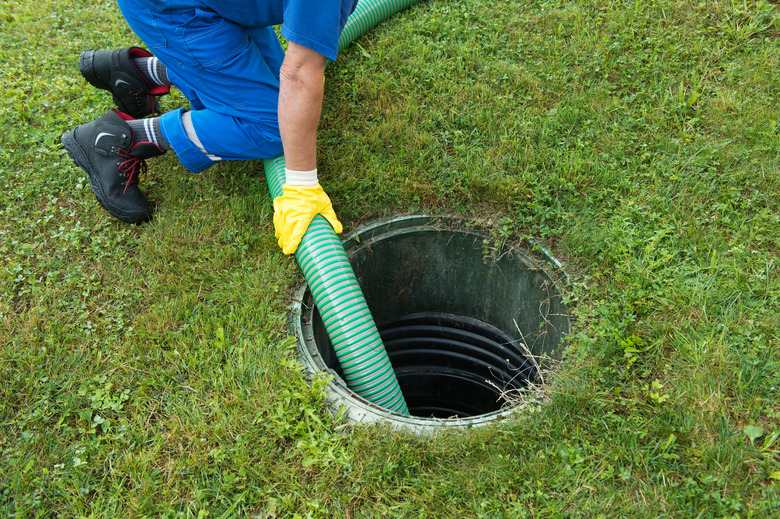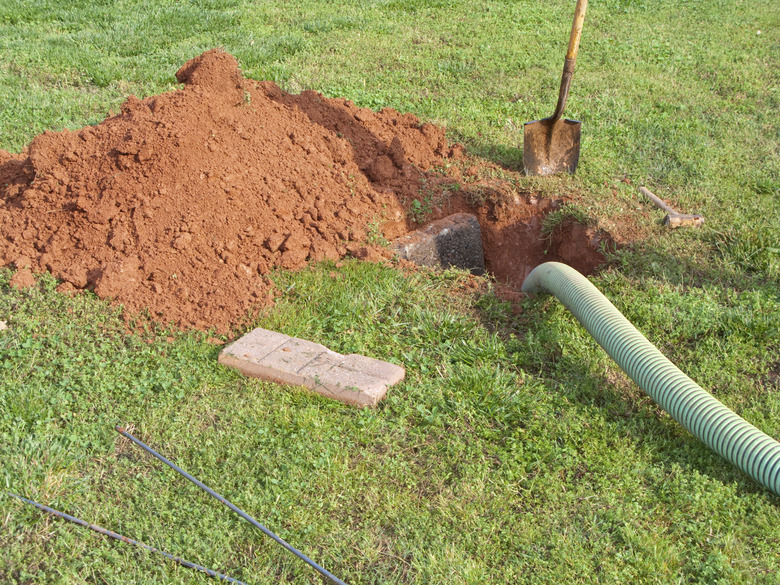Repair Costs For Common Septic System Problems
We may receive a commission on purchases made from links.
A well-maintained septic system can last 40 years or more, but sometimes, there are problems along the way. Many issues are fairly inexpensive to fix, but once in a while, you may find yourself faced with a pretty pricey septic system repair. If you're living with a septic system, it's smart to get an idea of how much repairs may cost you so that you're prepared if and when something does go wrong. There are also a few ongoing maintenance expenses associated with a septic system.
Why Such Wide Ranges?
Why Such Wide Ranges?
When you start shopping around for septic tank repair, you may find that most professionals are quite hesitant to quote a specific price. Instead, companies tend to give approximate repair costs in ranges, and some of these ranges vary a great deal. This is frustrating when you're trying to nail down costs, but people who work on septic systems know that they can be full of generally unpleasant surprises.
One reason pricing is difficult to obtain is that a large part of your septic system lives underground where you can't see it. What starts as a service call for a clogged pipe can turn into a large excavation project if the clog can't be removed by other means, and the repair person needs to go in after it. Sometimes, tree roots pose a problem, and the amount of labor required to cut them away and replace damaged pipes will also affect the price you pay for service. Tenacious tree roots can even try to uproot your septic tank and push it out of position. Shifting it back can get costly.
The takeaway is that until they've gotten their eyes on your system, a tech may not have a lot of concrete answers for you. If you're given a price range with a top end that is high enough to make you sweat, talk to your service person about it before the repair starts and come up with a plan to handle the costs if you're facing a potentially expensive problem.
Pumping It Out
Pumping It Out
On average, a properly sized septic tank needs to be emptied every three to five years. This isn't really a repair, but it is something you'll have to do to keep your system running smoothly. Septic tank pumping typically costs between $285 and $500 on average, and it's worth every dime. A full tank can make a big mess — one that you're financially and legally responsible for cleaning up.
Routine Maintenance Costs
Routine Maintenance Costs
The best way to avoid expensive septic issues is to have your system professionally inspected once a year. An inspection costs about $100 or $200 and can allow you to spot small problems before they become big ones. The most common issues found during an inspection are clogged filters and baffles.
If your inspector suggests these two fixes, it's best to make the repairs right away. A filter replacement costs between $200 and $300, while a new baffle runs between $300 and $900. These parts help make sure solid waste stays in your septic tank and doesn't end up anywhere it shouldn't be.
Removing System Clogs
Removing System Clogs
Clogs are perhaps the most common septic system issue. You likely have one if your drains are slow or your toilet flushes slowly. Gurgling pipes may also indicate a clog. To prevent them, be cautious about what you flush down your toilet and run through your drains. Hair, grease, and food particles are particularly good at causing clogs.
You may be able to clear a clog yourself using an auger, plunger, or liquid drain cleaner. Do not use harsh chemical cleaners, however, as these can damage your pipe and kill good bacteria that your septic system needs to break down waste and wastewater. Instead, use a natural clog remover.
If you don't have any luck, call in a pro. They can usually remove a clog for about $600. On rare occasions, however, they may need to physically access the clog, which can cost more.
Replacing Broken Pipes
Replacing Broken Pipes
Unfortunately, sometimes pipes crack, burst, or rust and require repair or replacement. Broken pipes can result in waste popping up in your yard, a soggy area in the lawn, or a patch of unusually lush grass. Repairing broken pipes starts at around $1,500 but can go up from there.
The price will increase if you have multiple broken pipes or pipes that are especially hard to access for some reason. If your pipes are looking uglier than anticipated, this repair can run up to about $4,200. Costs increase as a result of vegetation too. If you have tree roots growing into your pipes, you'll have the added labor expense of cutting them away and removing them.
Drain Field Repairs
Drain Field Repairs
When all is working well in your septic system, liquid waste (effluent) will leave your septic tank and percolate down through the soil of your drain field and become groundwater. If your drain field fails, however, you will notice puddles of standing water in your lawn. Sometimes, drain field failures are the temporary result of excessive water usage or heavy rains, and things will return to normal in a day or two.
If not, you need to have your drain field inspected. Sometimes, drain fields are repairable with a bit of aeration and refreshing but not always. If the water table has risen or if grease and waste made their way into your field, you may need to install a new drain field elsewhere on your property. Fixing drain field issues have an average cost between $6,000 to $15,000.
Replacing the Tank
Replacing the Tank
Septic tanks can last for up to 40 years, but not all of them do. If your tank cracks or springs a leak, you may need to replace it. This involves digging up and removing the old tank, leveling the area under the new tank with gravel, and installing the new tank. The new tank is then connected to your system, and topsoil is placed over it.
Septic tank costs range from $3,000 to $9,500 and largely depends on the type of tank you choose. Concrete tanks are between $700 and $2,000 before installation costs. Fiberglass is about $1,200 to $2,000, and polyethylene is $500 to $2,500. Note that local municipal codes may limit your tank choices by requiring a specific tank type or setup.
Septic Pump Problems
Septic Pump Problems
Some septic systems use a pump to push water from the septic tank into the drain field. A float sits on top of the tank, and when the water level rises, it trips the pump, which removes some of the water. These pumps sometimes fail. When they do, your septic tank will fill faster than usual, and you may notice some of the same symptoms you experience with a clog: stinky drains, slow drains, and backed-up drains.
Sometimes, the pump can be repaired for around $250 to $400. If not, you'll need to replace it. A new pump can cost $250 to $1,000 or more. It's important to weigh your options. Don't spend $400 fixing your old pump if a new one for your tank costs $250.
Tests and Permits
Tests and Permits
Installing a new septic system will naturally require a permit in most municipalities. Homeowners are sometimes surprised to find that replacing an existing system can also require permits. If you are planning to replace your septic tank, you'll probably need to pull a permit and have the new installation inspected before you cover the new tank with soil. The price of permits can vary a great deal from one location to another, but expect to pay between $300 and $500.
The same is true if you need to relocate your drain field. Constructing a new drain field not only requires a permit in most places but may also require soil testing. For a drain field to work properly, the soil must be permeable enough to allow water to pass through it and into the groundwater. If the soil is too heavy, the drain field won't work properly.
The opposite is also true. If the water flows through the soil too quickly, it may allow effluent from your septic tank to permeate into the groundwater before all of the bacteria has been removed. Many places require soil testing before they'll even issue a permit for constructing a new drain field. Soil testing typically costs between $750 and $1,850.
Retiring a Septic System
Retiring a Septic System
Septic systems are typically used in locations where there is no access to municipal sewer lines. As urban sprawl and housing developments creep closer to remote areas, however, you may have the option of getting rid of your septic system and hooking into a municipal line. If you choose to do this, be aware that you will need to take appropriate steps to shut down your septic system so that it doesn't deteriorate and cause a dangerous sinkhole later.
In some areas, the law requires you to remove your old septic tank and backfill the hole it once occupied. In other areas, you must pump the tank to empty it and then fill it in with soil. Shutting down the system typically costs about $1,000. You'll pay a little more if you're required to remove the plumbing in your drain field too.
References
- HomeAdvisor: How Much Does Septic Tank Repair Cost?
- Consumer Affairs: How Much Does a Septic Tank Cost?
- BuildingAdvisor.com: Soil and Perc Testing
- HomeAdvisor: How Much Does A Perc Test Cost?
- Ownerly: How Much Does a Septic Tank Cost?
- HomeAdvisor: How Much Does It Cost To Install Or Connect A Sewer Line?
- Mecklenburg County Government: Septic System Abandonment

